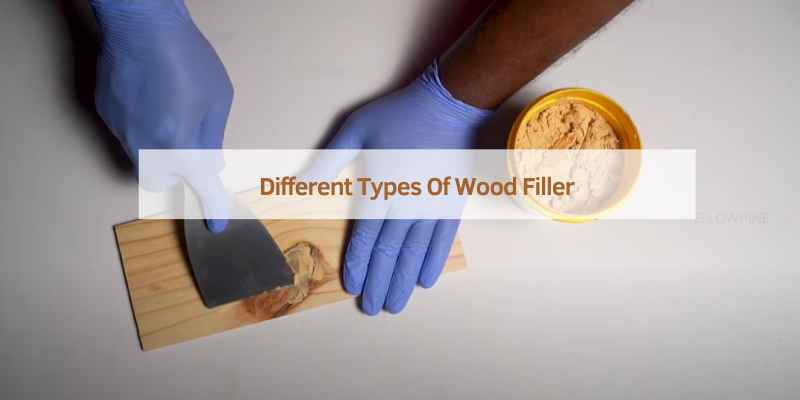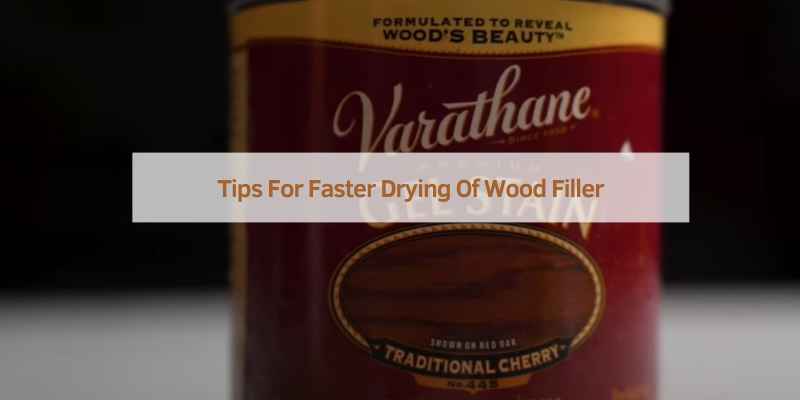Wood filler typically takes anywhere from a few hours to overnight to dry completely before it can be sanded smooth. It is essential to ensure that the wood filler is entirely dry before sanding, or it may cause damage to the repair.
Wood fine lines or holes due to everyday wear and tear are common and may require repairing using wood filler. If you are wondering about the waiting time for wood filler to dry before sanding, you have come to the right place.
We will discuss the drying time, different types of wood fillers available, and how to use them most effectively. By reading this article, you will gain essential knowledge about the wood filler and how to apply it to achieve a perfect look for your furniture or any wooden item.
Different Types Of Wood Filler
Wood filler can take anywhere from a few hours to overnight to dry before it can be sanded smooth. There are different types of wood filler available in the market, including fast-drying options like J-B Weld KwikWood Epoxy putty, Gorilla Wood Filler, and Minwax high-performance wood filler.
It is important to choose the right type of wood filler depending on the job requirements.
Wood fillers come in various types, each formulated for specific purposes. So before choosing a wood filler, it’s essential to consider the type of project you’re working on and the type of wood you’re using. In this section, we’ll discuss different types of wood fillers with a focus on the subheading: ‘Different Types of Wood Filler.’
Fast-drying Wood Filler
Fast-drying wood fillers are perfect for quickly repairing minor dents and scratches on wood surfaces. As the name implies, this type of wood filler dries fast, usually within 15-20 minutes, making it an excellent choice for small projects or fixing minor imperfections. One popular brand of fast-drying wood filler is J-B Weld KwikWood.
Epoxy Putty
Epoxy putties are a permanent fix for larger wood repairs as they are incredibly durable and stronger than other types of wood fillers. Epoxy putties have a clay-like texture, making them easy to shape, and once they harden, they become waterproof and can be sanded, drilled or painted over. Some of the best brands of epoxy putty are the Gorilla Wood Filler and the FamoWood Latex Wood Filler.
Wood Filler vs Putty
Though often used interchangeably, wood filler and putty are not the same things. Wood fillers are perfect for repairing large holes or gaps in wood, while putty is preferable for smaller cosmetic repairs. Wood putty is generally softer than wood filler, which makes it easier to sand once dry. Minwax Stainable Wood Filler and Dap Plastic Wood Wood Filler are excellent brands of wood filler available in the market.
In conclusion, different types of wood fillers react differently when subjected to external environments. Before choosing what to use, it is important to consider various factors such as the size of the project, type of wood, and environment to ensure that the filler will provide the desired level of repair and durability.

Factors Affecting Drying Time
Wood filler takes anywhere from a few hours up to overnight to dry completely before it can be sanded smooth. Factors affecting drying time include the brand of wood filler used, the depth, temperature, humidity and the size of the surface area.
It is important to read the manufacturer’s instructions carefully to ensure an optimal outcome.
When it comes to filling gaps or holes in woodwork, wood filler is a lifesaver. It is a plastic-based material that hardens and dries to a tough finish, ready for sanding and painting. However, the drying time for wood filler can vary depending on several factors.
Humidity levels
Humidity levels can significantly affect the drying time of wood filler. High levels of humidity in the air can cause the filler to dry slowly, while low humidity can speed up the drying time. This is because the moisture in the air can impact the evaporation rate of the filler. It is best to use wood filler when humidity levels are moderate, ideally around 50%.
Thickness of application
The thickness of the wood filler application can also affect the drying time. If the filler is applied in a thick layer, it will take longer to dry compared to a thin layer. It is recommended to apply the filler in thin layers, building up gradually until the gap or hole is filled.
Type of filler
Different types of filler can have varying drying times. The type of wood filler can be either water-based or solvent-based, and it is crucial to choose the right type for your project. Water-based fillers usually take longer to dry than solvent-based ones. Additionally, certain brands of wood filler may take longer or shorter to dry. It is essential to check the manufacturer’s instructions before use and allow sufficient drying time.
In conclusion, humidity levels, the thickness of application, and the type of filler can all affect the drying time of wood filler. Remember to choose the right type of filler, apply thin layers, and check the humidity levels for the best results. Once the filler is dry, you can sand and paint the surface to give it a seamless finish.
How To Apply Wood Filler
Wood filler can take anywhere from a few hours to overnight to dry completely before sanding. It’s important to follow the manufacturer’s instructions and allow enough time for the filler to harden properly before sanding to achieve a smooth finish.
After purchasing the right wood filler for your job, the next step is to apply it correctly. Applying wood filler is an essential step in achieving a smooth, seamless finish for your wood project. Here are the crucial steps to follow when applying wood filler:
Preparing The Surface
Start by preparing the surface that you want to fill. The surface should be clean and free from any dirt, grease, or dust. You can use a cloth or a brush to clean the surface. If your surface has cracks or openings, ensure you fill them with a putty knife before applying wood filler.
Applying Wood Filler
When applying wood filler, use a putty knife to fill the gaps and smooth the surface, ensuring the filler is evenly distributed. Avoid applying too much filler as it may take longer to dry. You can apply several coats of filler to ensure the surface is completely filled.
Sanding The Surface
Once the wood filler has dried, you can sand the surface to achieve a smooth finish. However, you need to wait until the filler dries completely before sanding. The drying time for wood filler may vary depending on factors such as temperature and humidity. It may take anywhere between a few hours to overnight for the filler to dry completely before sanding. We recommend reading product instructions to know precisely how long the filler you are using will take to dry.
In conclusion, applying wood filler is vital for achieving a smooth and professional finish for your wood project. Ensure you follow the steps above when applying wood filler to achieve the best results. Remember to select the right wood filler for your job and follow the manufacturer’s instructions carefully.
Drying Time For Different Types Of Wood Filler
Different types of wood filler have varying drying times before sanding. It typically takes a few hours to overnight for the filler to dry completely. Factors that can affect the drying time include the temperature and humidity of the environment, as well as the thickness of the filler applied.
When it comes to repairing wood surfaces, wood filler is often used to fill in gaps, dents, and other imperfections. However, before you can sand the surface smooth, the wood filler needs to dry completely. The drying time for wood filler varies depending on the type of filler used. In this article, we’ll discuss the drying time for three popular types of wood filler: fast-drying wood filler, epoxy putty, and latex wood filler.
Fast-drying Wood Filler
Fast-drying wood filler is a popular choice for those who need to make quick repairs. This type of filler typically dries within two to four hours, depending on the brand. Some fast-drying wood fillers are also sandable in as little as 15 minutes after application. However, it’s crucial to follow the manufacturer’s instructions carefully and ensure that the filler is completely dry before sanding or painting.
Epoxy Putty
Epoxy putty is another type of wood filler that’s known for its strength and durability. The drying time for epoxy putty is longer than that of fast-drying wood filler, with most brands requiring at least 24 hours to dry completely. However, the wait is worth it, as epoxy putty is resistant to water, heat, and chemicals – making it an excellent choice for outdoor repairs.
Latex Wood Filler
Latex wood filler is a water-based filler that’s easy to use and clean up. This type of filler typically takes longer to dry than fast-drying wood filler, with most brands requiring at least three to four hours’ drying time. However, some brands of latex wood filler can take up to 24 hours to dry completely, depending on the thickness of the application.
In conclusion, the drying time for wood filler varies depending on the type of filler used. Fast-drying wood filler typically dries within two to four hours, epoxy putty requires at least 24 hours to dry completely, and latex wood filler takes three to four hours to dry on average. However, it’s important to follow the manufacturer’s instructions carefully to ensure that the filler is completely dry before sanding or painting.
How To Tell If Wood Filler Is Dry
Wood filler is an essential component for ensuring a smooth and flawless finish on your woodworking projects. Once you’ve applied the filler on the necessary area, you need to give it ample time to dry before sanding and finishing. The rule of thumb is to wait until the filler is completely dry to get an even and smooth surface. However, how do you know if the filler is dry?
Visual Cues
One of the easiest ways to tell if the wood filler is dry is to check it visually. The surface of the filler will typically have a different appearance when it’s dry. Dried filler will have a matte or dull finish compared to the shiny surface of wet filler. Besides, if you have applied a colored filler, you’ll notice that the color becomes evenly toned when it’s entirely dry.
Touch Test
The other way to determine if the wood filler is dry is to touch it using your fingers. To avoid damaging the filler, use the tip of your finger instead of pressing hard on the surface. If the filler is not dry yet, it feels tacky when you touch it. However, fully dried filler will be hard, and you won’t leave any fingerprints on the surface.
Remember, how long wood filler takes to dry entirely largely depends on the product you’re using, weather conditions, and the thickness of the layer of filler you applied. Products like Minwax High Performance Wood Filler and DAP are known to dry faster than other fillers. It’s advisable to check the manufacturer’s instructions to know the estimated drying time.
Tips For Faster Drying Of Wood Filler
Waiting for the wood filler to dry can be a time-consuming process. However, there are ways to speed it up. Here are some tips for faster drying of wood filler:
Using A Fan Or A Heater
If you want to speed up the drying process of the wood filler, using a fan or a heater is an effective method. The moving air will help evaporate the moisture from the filler, making it dry faster. However, make sure not to place the heater too close to the wood as it can cause damage.
Reducing Humidity Levels
Humidity can affect the drying process of the wood filler. To reduce humidity levels, you can use a dehumidifier or an air conditioner. This will help in evaporating the moisture from the wood filler, making it dry faster. Additionally, you can also keep the room well ventilated and avoid working in humid conditions.
It is essential to let the wood filler dry completely before sanding, as any moisture left in the filler can cause damage to the wood surface. With these simple tips, you can speed up the drying process of the wood filler and get your project done in no time.

Frequently Asked Questions On How Long Does Wood Filler Take To Dry Before Sanding
How Long Does Wood Filler Take To Harden?
Typically, it takes anywhere from a few hours to overnight for wood filler to harden before it can be sanded smooth.
How Long Before Sanding Filler?
It may take anywhere from a few hours to overnight for wood filler to dry completely before it can be sanded smoothly.
How Long Does It Take For Putty To Dry Before Sanding?
Typically, it may take anywhere from a few hours to overnight for putty to dry completely before it can be sanded smooth.
Does Wood Filler Shrink As It Dries?
Yes, wood filler shrinks as it dries. It is not recommended to apply wood filler on finished wood or in exterior settings as it can fail in the event of expansion and contraction. The drying time varies depending on the product, but it typically takes anywhere from a few hours to overnight before it can be sanded smooth.
Conclusion
Wood filler is a reliable solution for fixing damages in wooden surfaces. While it may take anywhere from a few hours to overnight for the filler to dry depending on the type and thickness, it is important to allow proper time for the wood filler to dry before sanding.
This ensures that you achieve a smooth, seamless, and durable result. With the right technique and the correct product, you can easily restore the beauty and integrity of your wooden surfaces.


